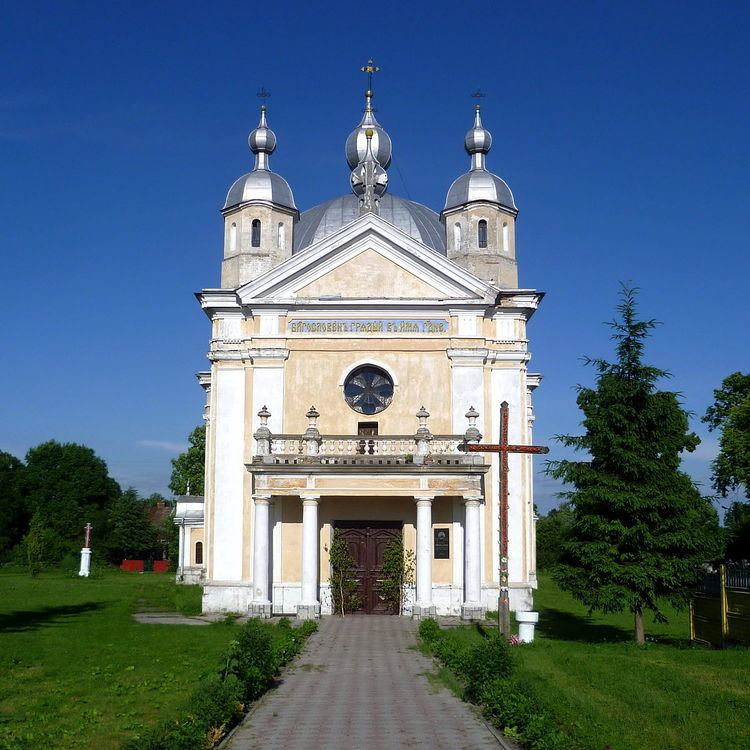Local time Thursday 9:09 PM | Oblast (province) Lviv Area 248 ha Population 1,007 (2013) | |
 | ||
Weather 6°C, Wind SE at 5 km/h, 78% Humidity | ||
Uhniv ukraine
Uhniv (Ukrainian: Угнів, Polish: Uhnów, Yiddish: הובנוב) is a city in Sokal Raion, Lviv Oblast (region) of western Ukraine. Population: 1,007 (2013 est.).
Contents
- Uhniv ukraine
- Map of Uhniv Lvivska Ukraine
- Uhniv church of the assumption of our lady ruins part ii
- History
- Jews of Hivniv
- References
Map of Uhniv, Lvivska, Ukraine
Uhniv (or Uhnow, Uchnów or Hivniv) is the smallest city of Ukraine apart from a couple of cities in the Chernobyl Exclusion Zone in northern Ukraine. It is part of the Sokal Raion and is located 22 km from Belz and 21 km from Rava Ruska. The capital of the district is Lviv (Lwów). It is located almost on the Ukrainian-Polish border. It was passed to Ukraine as a result of the 1951 Polish–Soviet territorial exchange.
Uhniv church of the assumption of our lady ruins part ii
History
At the end of 2nd century AD the Goths invaded Galicia. They conquered the Hivniv area and settled there. At the end of the 4th century the Huns conquered and replaced the Goths. In the middle of the 5th century the Slovenes took control of the area. In 1019 the area was conquered by Polish Crown; until 1462 the area was under ducal control. In that year Belz was established as a capital of voivodeship (pol. województwo) under Polish rule - this district included the town that was later called Hivniv. The settlements in the Belz area belonged to various owners; some to the kingdom (these were called crown cities) and some individuals called squires. In that year (1462) King Casimir IV Jagiellon gave town privileges and the name Uhnów (Hivniv) to the place, so the village became an independent town, free of wider supervision. The inhabitants were not under the squires control but under the king's rule.
In 1477 several villages were included in the general area of Hivniv, This area was extended 1n 1595. In 1914 there were more than 20 villages surrounding the town of Hivniv.
In 1497 the crusaders came to the district to help the Polish king against Tutkish invaders. In 1548-9 the Tatars invaded; from 1648-1655 the area suffered from the Cossack uprising under Bohdan Khmelnytsky, hetman of the Zaporozhian who joined forces with the Tartars against Poland. In the following years many wars took place there.
From the first partition of Poland in 1772 until 1918, the town (named UHNOW) was part of the Austrian monarchy (Austria side after the compromise of 1867), in the Rawa ruska (Rava-Ruska) district, in Austrian Galicia province (Crown land). The fate of this province was then disputed between Poland and Ukraine, until the Peace of Riga in 1921.
A post-office was opened in 1857. After World War II, along with the 1951 Polish–Soviet territorial exchange, the Soviet Union took control of the area.
Jews of Hivniv
The Jewish community of Uhnow (Hivniv) goes back very far. There is little historical evidence of this since. The place is too small to be mentioned in Jewish or other records. But thanks to famous rabbis who are mentioned in various sources because of their importance, it is clear that a Jewish community existed there for at least 350 years and even had a rabbinical court and Judge.
In 1629 30 families. In 1648-9 100 families.
Rabbi Shmuel Feivish, son of Rabbi Nathan Feitel, wrote in 1658, in his description of the Khmelnytsky massacres called Tit ha-Yaven:
"From there the enemy went to Magerov where there were about 100 families who escaped to Narol (mentioned before). From there the enemy went to Potelych - also about 100 families - who escaped to Narol. The enemy went to Rava-Ruska which had 100 families and they also ran away to Narol... In Narol there were 600 householders, not counting refugees; altogether more than 5000 families. As a result of our many sins, a terrible decree was issued and more than 10,000 people were killed, including woman and children.
from there, the enemy advanced to Belz which had about 200 families. In addition, Belz had more than 10,000 families who escaped from other towns because Belz was a very strong city. But some died of hunger. From there the enemy went to Uhnów (Hivniv) which had 100 families - they all were killed by their enemies. From there the enemy went to Tishevitz which had 100 families and killed most of them. The enemy went to Sokal which had 100 families who had behind a very thick wall which was built like a fortress and so were saved".
The Jewish community was rebuilt by Jews from the surrounding area. After calm restored, they came out of hiding, built new homes, and lived there until World War II.
